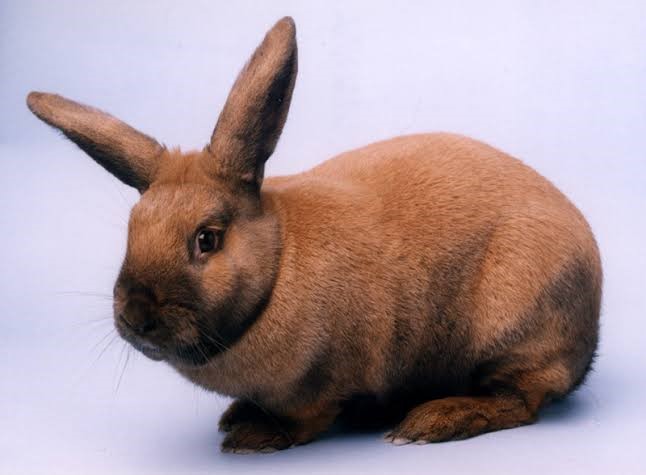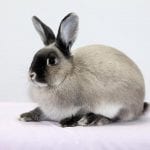Scientific Facts
| Common Name: | Thuringer Rabbit |
| Scientific Name: | – |
| Life Span: | 5 to 8 years |
| Size: | 8 to 10 pounds |
| Habitat: | Domesticated |
| Country of Origin: | Free State of Thuringia |
Thuringer Rabbit Information
The Thuringer Rabbit is a domesticated breed of rabbit that was originally bred in Thuringia, a state of Germany. They were bred back in the 1900s primarily for commercial purposes for their fur as well as their meat. While this rabbit is very popular in many European countries, it is not recognized by the American Rabbit Breeders Association. These rabbits are no longer as prominent as they used to be back in the 1900s due to how World War II affected their numbers. But they have since been starting to recover in terms of their population.
Physical Description

The Thuringer Rabbit is a medium to a large-sized rabbit that can be as heavy as about 10 pounds or even more if you have yourself an obese rabbit. These bunnies were made to be really stocky and round-shaped due to how they were once commercially sold for their meat in places were rabbit dishes are a delicacy among locals. Meanwhile, the head is actually quite developed nicely and sits really close to the rest of its body as this bunny what looks like a short neck. The Thuringer Rabbit’s ears are also upright and can be 4 to 5 inches long. At times, its ears can look longer than the rest of the head.
In terms of its coat, the Thuringer Rabbit has fur that is really silky and soft to the touch. It might be thick at times, but it is not dense enough to make it difficult to manage. Meanwhile, Thuringer Rabbits come in a distinct color that really gives it its identity. These rabbits are somewhat close to charcoal and have shades of yellow and blue-black all over its body. You would say that the Thuringer Rabbit may look amber at times but is generally a combination of dark brown, black, and yellow.
Personality

A Thuringer Rabbit’s overall temperament and personality are more or less fit for a domesticated breed of rabbit. This bunny will usually display a personality that is quite friendly and playful. It loves interacting with its owner and will always want to be around you for some social moments and some time to try to feel affectionate. They really like the attention you give them so long as you try to stay positive towards them. In turn, Thuringer Rabbits will also try to show some affection towards you as well.
Generally regarded as a rabbit that is really docile, a Thuringer Rabbit will easily submit to how its owner handles it. It will more than likely stay calm when you are handling it and will not fret around a lot. In that regard, they are fun and easy pets to have and are some of the best types of rabbits for a family due to how they are fit for small children and older owners alike.
Life Span
When given the best kind of care that they need, Thuringer Rabbits can live for about 8 years or even more. But, as long as you stay attentive to their basic needs, these rabbits will most likely live for about 5 years.
Reproduction
The Thuringer Rabbit follows the same reproductive behavior of any common household rabbit in the sense that they will reach sexual maturity by the time they are 4 to 5 months old. Meanwhile, they can give birth multiple times in a single year due to how short their gestation period is. Thuringer Rabbits can have a maximum litter size of about 5 to 7 rabbits.
Behavior
The Thuringer Rabbit is generally one of the calmer breeds of domesticated rabbits as they are actually really good-natured in the way they behave. These affectionate rabbits will more than likely stay well-behaved at all times even when you invite them for some playtime. When you let them out of their cage and try to play with them, they also stay calm in the way they approach social interactions and are almost never too hyperactive. The Thuringer will friendly and playful enough to be a really good rabbit to have around.
As far as handling the Thuringer Rabbit is concerned, you will really enjoy how well-behaved it is. It is docile when you try to handle it and will almost always enjoy getting handled as long as you stay patient and do it right. When you let them loose, they like running around, especially when they are with other rabbits that have the same kind of demeanor. Thuringer Rabbits are also very curious and will try to explore their surroundings as much as possible when they are out of their cage. At times, they might even climb on anything they feel comfortable to climb onto.
Eating Habits
The Thuringer Rabbit has the same kind of nutritional needs as any other domesticated breed of rabbit. It prefers to be fed with plant-based products and better off eating grass or hay. Thuringer Rabbits should do well when you put them on a diet that is composed primarily of hay or grass. You can also feed them with commercially sold rabbit pellets as these tend to have a similar nutritional value as grass or hay.
Meanwhile, you can safely provide your Thuringer Rabbit with vegetables and fruits to supplement a diet that is hay or pellet-based. Make sure to watch the type of vegetables you feed them as these rabbits are quite prone to obesity. Most vegetables and fruits will be too calorie-dense compared to hay and may actually contribute to rapid weight gain.
Water
Thuringer Rabbits can be quite active when they are allowed to let loose of their cage. In that regard, they need to rehydrate regularly. Provide them with fresh clean water that is constantly replaced to make sure that your rabbit is free from any water-borne disease or illness.
Cage
Thuringer Rabbits are not the most demanding types of rabbits in terms of where they are housed. When you choose to house them indoors, a good commercial rabbit cage will be enough as such cages were designed to be fit for domesticated rabbits. However, you may need to give them a cage that is suitable to them in terms of size due to how active and big Thuringer Rabbits tend to be.
Housing them outdoors requires you to put them somewhere that is safe for them in terms of climate and overall outdoor conditions. A simple enclosure made of wood and metal wire will be enough. Make sure that the wires are high enough to prevent this rabbit from trying to escape. An outdoor enclosure can be good for the Thuringer because they tend to like to roam around a lot regardless of where you put them. And because they are prone to obesity, allowing them to have enough space to exercise will contribute to an overall healthy and manageable weight for these rabbits.
Availability – Where to Get one
Thuringer Rabbits can be a bit rare in the United States because they are not recognized by the ARBA. However, although their population is still recovering, they are popular in Europe and may be purchased there much easier than in the US. Importing them might cost you extra, but that might be the best way for you to get your hands on Thuringer Rabbits if they are too rare in the US.
How to Care for a Thuringer Rabbit
Thuringer Rabbits are not really difficult to take care of. They generally prefer to be in an environment that is calm, safe, and large enough for them to feel free. These rabbits like to roam around to inspect their environment as well as to play with their owners. In that regard, give them their much-needed playtime and the social interaction they require to feel affectionate.
In terms of their overall diet, make sure to watch the portion size of the food you give your Thuringer Rabbits because they tend to be prone to obesity. Make sure to minimize high-calorie fruits and vegetables to prevent rapid weight gain. Also, be sure to allow them to roam around as this gives them the exercise they require to manage their own weight.
FAQs
Is the Thuringer Rabbit a good pet to have?
Thuringer Rabbits are generally very good pets to have for any kind of owner. Although they are regarded as quite active, they are calm and easy to get along with due to how docile they also are.
Are Thuringer Rabbits common?
Thuringer Rabbits can be quite difficult to find in the US but are more common in Europe.
For what purpose was the Thuringer Rabbit bred for?
Thuringer Rabbits were once bred for commercial purposes because their meat and their fur were saleable.
Why does my Thuringer Rabbit climb on my furniture?
The Thuringer Rabbit is considered to be very curious and will try to explore its environment as much as possible.

